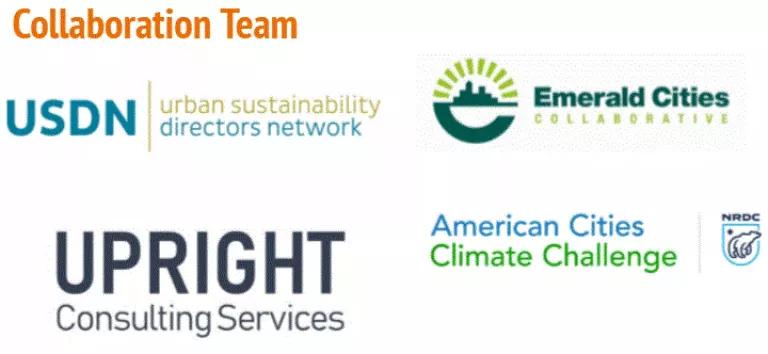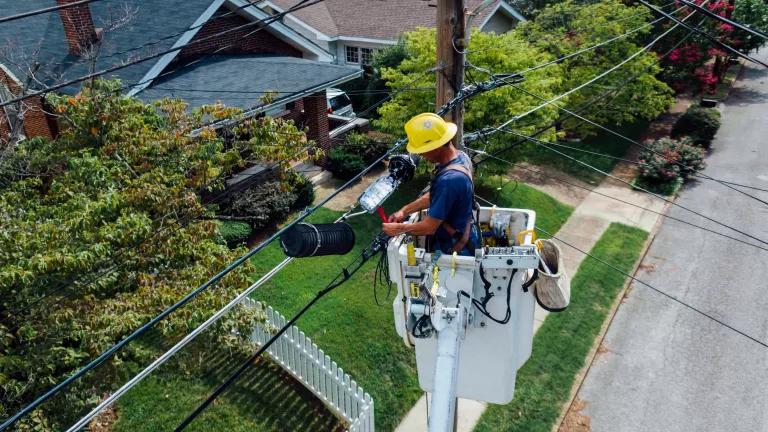How Cities Can Center Equity in Buildings Policy
A new resource from Urban Sustainability Directors Network (USDN), Equity and Buildings: A Practice Framework for Local Government Decision Makers, builds on the expertise of Black, Indigenous, and People of Color-led (BIPOC) organizations to help local practitioners center equity in their building decarbonization policies.

Co-authored with Manisha Rattu, Upright Consulting Services
Racial equity is a key priority for city governments participating in the Bloomberg Philanthropies American Cities Climate Challenge. A new resource from Urban Sustainability Directors Network (USDN), Equity and Buildings: A Practice Framework for Local Government Decision Makers, builds on the expertise of Black, Indigenous, and People of Color-led (BIPOC) organizations to help local practitioners center equity in their building decarbonization policies.
Local governments have a key opportunity to support communities most impacted by racial inequities by being intentional about the role they play in planning for new construction and regulating existing buildings. However, doing so requires embracing equity as a consistent practice rather than a prescription, and leaning into continuous commitment, learning, iteration, and improvement. The Practice Framework advances the concept of co-equal climate and equity goals, emphasizing the role that building climate policies play in either sustaining or reducing inequities. See here for the Framework’s topline 12 Principles of Practice.
The Framework was brought together by a core team consisting of USDN, the Climate Challenge, Emerald Cities Collaborative, and Upright Consulting Services. It combines expertise from leading equity-focused organizations such as Greenlining Institute, Emerald Cities and NAACP’s Centering Equity in the Sustainable Building Sector Initiative, to lay out concepts and practices that can help cities and BIPOC communities work together more effectively toward climate equity outcomes. In addition to the core team of contributors, an advisory committee made up of local city practitioners and BIPOC-led organizations provided suggestions throughout the process. This helped ensure that the Framework was responsive to the equity concerns facing frontline communities and conveyed in a manner that local government staff could implement.
Part 1 of the Framework centers Equity Fundamentals that need to be in place prior to policy design. These Fundamentals include establishing an equity definition, a why statement, an equitable approach to community engagement, and more. Part 2 highlights critical issues and opportunities at the intersection of equity and sustainable buildings, which we summarize briefly below. See here for the full framework.
Housing Affordability
About half of all renters in the U.S. are housing cost burdened, which means they spend more than 30-50+% of their household incomes on rent. Renters, who make up a third of all U.S. households, are especially vulnerable to potentially harmful built environment policies and often have little to no power in voicing their concerns. Well-designed and targeted funding of building policies is needed to ensure that renters are not expected to front costs to meet building improvement requirements.
In Atlanta, where energy burden is the fourth highest in the country, the Partnership for Southern Equity is using energy burden maps to focus energy education work and policy engagement in high-burden neighborhoods. The data and maps have helped support targeted outreach and assistance for property owners and pushed Georgia Power to inform two low-income efficiency pilot projects.
Gentrification and Displacement
Government investments in sustainability and climate resilience can lead to green gentrification and displacement as areas become more desirable and property values increase. Building owners who are required to make improvements and/or provided with incentives may use the requirement as a reason to evict tenants or increase costs, making the property unaffordable for existing residents. Protections for current residents, especially low income tenants, are needed to ensure that they are able to access green amenities and continue to live in their homes without any added burdens. Addressing these pressing issues requires deep interdepartmental collaboration, which is detailed further in the framework.
In Massachusetts, the LEAN Multifamily Program serves residents of low-income and moderate income housing with 5 or more units. The program works with the utility to provide incentives to building owners for comprehensive energy efficiency upgrades. In return, the building owners must sign an affordability agreement and for-profit owners must commit to preserving affordable rents.
Health
As a result of historical and structurally inequitable policies like redlining, many Black, Indigenous, Latinx, and other families of color live in substandard housing where they are more likely to be exposed to mold, lead, asbestos, pests, and other harmful dangers. These dangers can lead to increased stress, asthma, lead poisoning, and other diseases. Energy efficiency programs can be combined with health inspections and cleanups that can increase the quality of life for residents.
In Fort Collins, Colorado, city sustainability staff initiated a program through which community volunteers were trained to offer cost-free healthy home inspections. The volunteers identify health and safety hazards and provide comprehensive recommendations, along with referrals to utility incentive programs.
Economic Inclusion
All climate policies have economic impacts that can lead to outcomes like good quality jobs or can further entrench existing economic inequities. For example, building policies may generate the need for skilled workers in a new sector, hence, requiring that workers be trained to meet this new demand. Investments in pre-apprenticeship and training programs can help ensure that a workforce is ready to take on the new jobs. Since women and minority owned business enterprises are often underrepresented in the trades and union jobs, providing opportunities for them to receive contracts and/or training can help distribute economic opportunities to communities who need them the most.
Based on the California Building Decarbonization Workforce Needs and Recommendations study, building electrification policies in California will create more than 100,000 new construction jobs annually for 25 years. With electrification, many gas extraction and utility jobs will be phased out so there is an opportunity to train existing and new workers in the decarbonization sector, and, while doing so, generate specific opportunities for BIPOC workers.
Cultural Recognition, Identity, and Tradition
Local communities have different relationships and interactions with the built environment, and may respond varyingly to buildings policies. For example, large scale electrification efforts often involve moving away from gas stoves to electric or induction cooktops. For some communities, cooking on a gas stove is integral to their traditional cuisines and, while a shift to electric stoves is a safer and healthier option, it requires a change in lifestyle and diet that may be challenging for many. Additionally, energy efficiency information and programs are often not made available in the main languages of many community members.
The Empower Me program in British Columbia relies on community mentors to connect with home owners. The mentors share information about appliances and how to increase the overall health and safety of a household in the homeowner’s preferred language. Since 2012, the program has grown across Canada and works with many BIPOC communities.
Resilience to Disaster and Disruption
Natural disasters like the wildfires in California and the winter storm in Texas, along with the Covid-19 Pandemic, have emphasized the need for resilient housing. Energy efficiency upgrades should also help preserve the habitability of buildings during extreme heat and cold. It is also important to think of potential future risks and build the infrastructure needed to withstand those challenges.
In New York City, an affordable housing complex, the Marcus Garvey complex, completed a large retrofit that included adding back-up power for a community center due to increased brownouts during the summer months. In doing so, if there are future heat waves and residents need to keep cool, they can head to the community center.
In Part 3, the Framework concludes with ideas for sustaining and funding work in partnership with community organizations and lifts up key reference documents for further exploration of the topics introduced throughout the framework.
Next Steps
Interested in learning more about the Framework or participating in future workshop series on this topic? Please get in touch by filling out this online form.



